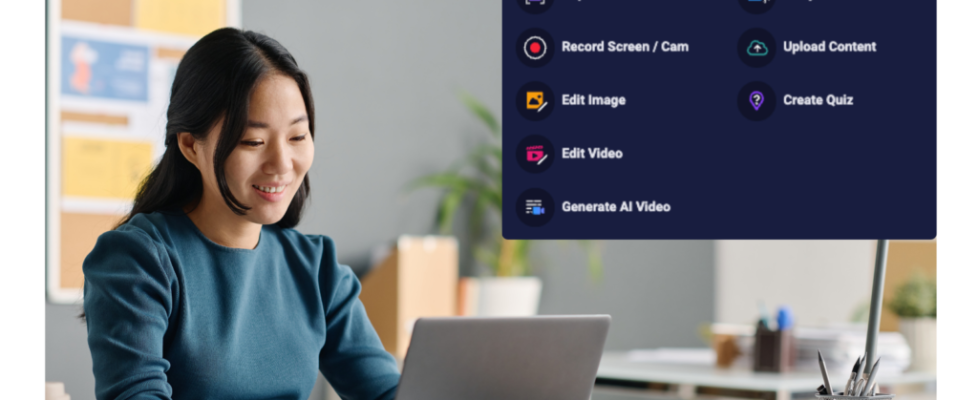Lights, Camera, Action! It’s time to create your own student newsroom. A student newsroom is a great way to increase engagement, creativity, and learning within the classroom. What’s even better is that your students are the video producers of their own newscast.
You can guide students in their learning by assigning stories or topics. Help them stretch their creative minds. Here are just a few tips to turn your class into a hustling, bustling newsroom.
Be the Editor-In-Chief
Put your Editor-In-Chief hat on, and start assigning roles to each of your students. This helps students take responsibility of their role and holds them accountable for work that’s assigned in class. Have a list of roles including news anchors, producers, writers, reporters, video editors and general production staff. You can change their roles on a weekly basis so that students experience work at all levels.
You can record a quick explainer video to demonstrate what each role does and what they are responsible for. You may want to showcase an example of the job from the ‘real’ world. Grab a video from YouTube or your local news station and add it to your explainer video to illustrate what’s expected from the job.
Create an atmosphere for news
To help everyone get in the ‘news’ zone, try to replicate a real newsroom. Move desks around so you have enough space to record your newscast. Designate an area for your green screen backdrop, desk, and hosts.
You can group your students into teams, and designate each a working area. For example, have your video editors work in the ‘edit bay.’ You can also have your producers work alongside your writers to increase student collaboration of stories.
If you’re learning remotely, you can also assign students their own roles and they can begin to create their own video stories at home. You can turn to your favorite news station to get ideas on how they are reporting in a remote setting. For example, CNN anchors are reporting from separate locations with a green screen background behind them.
Brainstorm and research together
The day begins with the brainstorming meeting. Have students walk into your meeting with story ideas. This helps increase class participation. You’ll soon find enthusiastic students pitching ideas for the student newscast.
You can also help students come up with story ideas. Go over current news and events. Have them research class topics and report about them. Use this valuable class time to answer questions and help boost confidence in their stories.
Turn on the visuals
Take the creativity to the next level by designing visuals for your newscasts. Have your creative team of students collaborate with reporters and producers on the ‘look’ of the newscast.
You can use the green screen background and add in a creative image to illustrate each story that’s being presented. You can also use ScreenPal’s Overlay Rich Text feature to create animated title graphics for the newscast.
If you need to find the perfect visual, ScreenPal has a stock library filled with hundreds of thousands of images and videos your students can use. They can get creative with the amount of visuals they can use. Just add an image or insert a video from the stock library.
Turn to scripts to stay organized
The story is almost done. All your student needs to do is record their audio over their script. There’s a great feature in ScreenPal that makes it easy to organize and record scripts. The Scripted Recordings feature allows students to record their voice and add video to their story.
It’s an easy line-by-line creation process. Simply copy and paste the script into Scripted Recordings.
Students are able to create a video story, all in one platform.
Imagination comes alive with the video editor
 After they have created their scripts and recorded their voice narration, then it’s time to turn to ScreenPal’s Video Editor. It’s not hard to learn how to use the video editor. In fact, it’s easy-to-use and it gives students a load of options to be creative with their stories.
After they have created their scripts and recorded their voice narration, then it’s time to turn to ScreenPal’s Video Editor. It’s not hard to learn how to use the video editor. In fact, it’s easy-to-use and it gives students a load of options to be creative with their stories.
Students can add images, text, arrows and more. If they need to update a story, they can import previous recordings or videos they have done into their new video. They can also insert videos from other devices to enrich the topic.
With the video editor, students will learn useful editing skills as they enhance and polish their videos. They’ll be able to take responsibility for their creativity and have a great way to show it off in class.
The news for learning
Busy reporters are often kicked off smaller stories to cover breaking news. Get in on the action, by creating your own breaking news videos. You can use the screen and webcam recorder to showcase a student reporting on a current event.
You can also use the webcam to record interviews with other students. Ask them their thoughts on world news or what’s happening on campus. This video interaction is a great way to increase their level of creativity.
By giving them easy tools to create, you are helping students become engaged in their learning. All you need to do is turn the camera on them and say, “Lights, Camera, Action!”


































